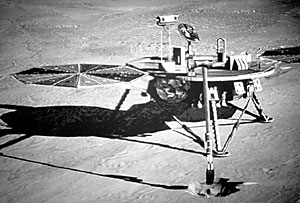 |
|
File Photo
|
The Phoenix Mission, a NASA commissioned project that will send a "lander" to the red planet in August 2007, making it the first university-launched mission of it's kind.
|
|
|
By Danielle Rideau
Arizona Daily Wildcat
Wednesday, June 8, 2005
Print this
NASA approved a Mars mission last week that will send a "lander" to the northern polar region of the planet in August 2007 to dig for signs of possibile of life.
The Phoenix Mission will send a long-arm lander to the icy surface of the Martian planet to dig through soil layers in search of "habitable building blocks of life," said Doug Lombardi, UA education and public outreach manager working on the mission.
The project, which is funded with a $386 million grant from NASA, will take a ten-month cruise to the planet, and perform three months of testing to search for life, Lombardi said.
The 10-month cruise will launch from NASA's Kennedy Space Center in Florida and be controlled from NASA's Jet Propulsion Laboratory in Pasadena, Calif., the release said.
When the stationary lander does land on the surface of Mars, it will be controlled by principal investigator Peter Smith, UA senior research scientist in the Lunar and Planetary Laboratory, and his team of scientists from their building, 1415 N. Sixth Ave., Lombardi said.
During the lander's three-month stay on Mars, it will be taking images of the surface with its camera systems designed and built by the Phoenix Mission team, Lombardi said.
"One of the cameras is panoramic, and is made to replicate the human eye with a two-lens system," Lombardi said. "Its images will have a 3D effect."
This project is the first university-launched mission in the country, and, Lombardi said, NASA's choice "shows confidence in their leading solar system exploration program," Lombardi said.
In a news report by KVOA News, Smith also from the UA, said he hopes that this project, which will bring $50 million to the UA, answers the question, "Are we unique in the universe, or is there life on Mars?"
